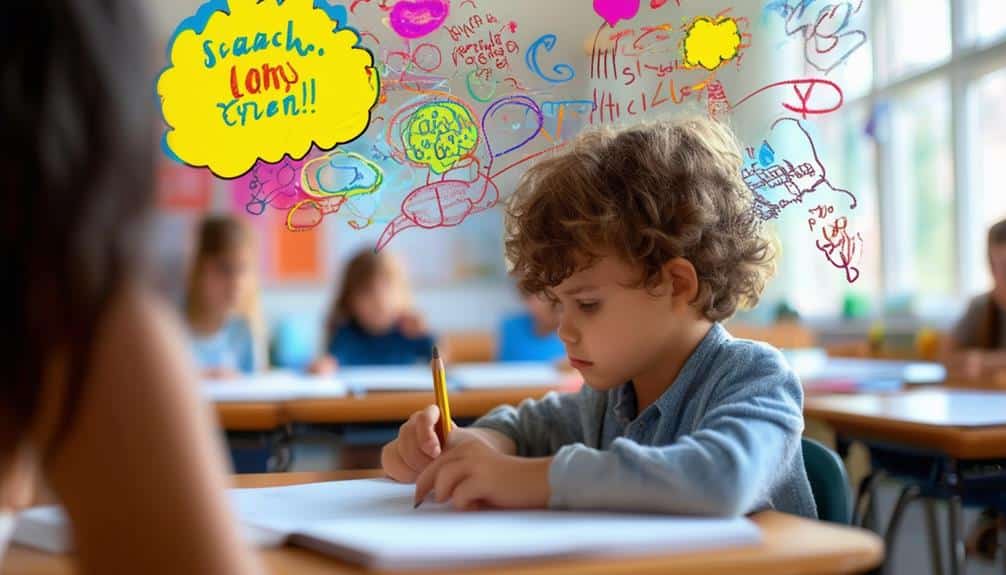Recognizing ADHD early is vital for helping your child get the support they need. If your child struggles with inattention, can’t focus for long periods, or frequently loses items, these could be early signs. Hyperactivity may show up as constant restlessness or difficulty staying still, while impulsivity often leads to hasty decisions and challenges in social settings.
It’s essential to recognize ADHD early, especially if your child has trouble following instructions, leaves tasks unfinished, or often forgets important things like appointments or assignments. Sensitivity may also be a clue, as children with ADHD can have intense reactions and frequent tantrums, particularly in toddlers. Knowing these signs will help you take the following steps in addressing this condition.
Key Takeaways
- Difficulty sustaining focus and frequent distractions are early signs of inattention in ADHD.
- Excessive fidgeting and inability to stay still indicate potential hyperactivity.
- Acting impulsively without considering consequences is a common ADHD trait.
- Forgetfulness of appointments and instructions can signal memory-related challenges associated with ADHD.
- Intense emotional reactions and frequent tantrums may point to emotional dysregulation, often seen in ADHD.
Inattention
Inattention in children with ADHD often manifests as an inability to sustain focus on tasks or activities, significantly impacting their academic and social development. These children frequently struggle to concentrate, are easily distracted, and overlook essential details in schoolwork and daily activities. This inattention can lead to significant challenges in organizing tasks and following through on instructions, which are vital skills for academic success.
Children with ADHD experiencing inattention often misplace necessary items, adding to their organizational struggles. This forgetfulness and frequent daydreaming contribute to inconsistent academic performance, as they may fail to complete assignments or miss essential steps in multi-part tasks. Such academic hurdles can result in lower grades and increased frustration, both for the child and their educators.
Moreover, the impact of inattention extends beyond academics, affecting social interactions as well. Children with ADHD may find it challenging to follow conversations or stay engaged in group activities, leading to social isolation or misunderstandings. This can hinder their ability to form and maintain friendships, further affecting their overall development. Addressing inattention through tailored interventions is essential in supporting these children’s academic and social success.
Hyperactivity
Hyperactivity is a hallmark symptom of ADHD, often characterized by constant restlessness and an inability to stay seated for extended periods. Children frequently exhibit excessive fidgeting and may engage in ongoing running or climbing, making participating in structured and quiet activities challenging. These behaviors can significantly disrupt their learning environment and social interactions, necessitating early intervention and tailored treatment strategies.
Constant Restlessness Observed
Children diagnosed with ADHD frequently display persistent restlessness, characterized by fidgeting, squirming, or an inability to remain seated for prolonged periods. This hyperactivity often manifests in various forms, including excessive running or climbing in inappropriate situations and critical observations during clinical evaluations. Teachers and parents might notice a child’s persistent movement or a continuous need to be ‘on the go,’ which stands out from typical childhood energy levels.
Clinical assessments focus on behavioral observations to identify signs of restlessness that surpass regular activity. This can include the child’s inability to engage in quiet activities or their constant state of motion, even in calm environments. Such behaviors are essential indicators for early recognition and diagnosis of ADHD.
| Behavior | Description |
|---|---|
| Fidgeting | Continuous movement of hands or feet, difficulty remaining still. |
| Squirming | Shifting position frequently while seated, unable to stay in one place. |
| Excessive Running | Running around excessively, particularly in inappropriate settings. |
| Climbing | We climbed on furniture or other structures, often in risky or unsuitable places. |
| Persistent Movement | Constantly being ‘on the go,’ unable to engage in passive activities. |
Timely and accurate identification of these behaviors through clinical evaluations and behavioral observation is essential for providing appropriate support and resources for children with ADHD.
Difficulty Staying Still
Although hyperactivity is a cornerstone of ADHD, it often manifests as an overwhelming difficulty for children to remain still, significantly affecting their daily activities and interactions. This hyperactivity can be observed through excessive movement, such as fidgeting and squirming in their seats. These children may frequently be seen running or climbing excessively in situations where it is inappropriate, further complicating their ability to engage in quiet activities or focus on tasks.
Excessive talking is another common manifestation of hyperactivity, which can impede classroom learning and social interactions. The relentless need to move or talk can majorly impact a child’s ability to concentrate, potentially resulting in academic challenges and social difficulties.
It is important to note that hyperactivity may present differently in girls compared to boys, often leading to underdiagnosis in females. Girls with ADHD might exhibit less overt hyperactive behaviors and instead engage in more subtle forms of excessive movement or talking, making their symptoms less noticeable.
Recognizing these signs early on is vital for timely diagnosis and intervention. Early recognition and appropriate management can help lessen the impact on focus and overall functioning, ultimately supporting the child’s development and well-being.
Impulsivity

Identifying impulsivity in children with ADHD involves recognizing patterns of acting without thinking, frequent interruptions, and a propensity for making hasty decisions. Impulsivity is one of the hallmark characteristics of ADHD. It is marked by impulsive behaviors such as yelling out answers, interrupting others during conversations, and taking risks without considering the consequences. These behaviors arise from a struggle with self-control and can significantly impact a child’s decision-making skills.
Children with ADHD often make quick decisions that can lead to social challenges, conflicts, and even safety concerns. For instance, they might suddenly dart across the street without looking or interrupting a peer, causing friction in social settings. Such reckless actions affect their relationships and academic performance, as they may struggle to wait their turn or follow classroom rules.
Understanding and managing impulsiveness is essential in ADHD treatment. Strategies to improve self-control and decision-making skills can help mitigate the adverse effects of impulsivity. Interventions might include behavioral therapy, structured routines, and support from caregivers and educators. Addressing impulsiveness early can foster a more supportive environment that enhances the child’s ability to effectively navigate social interactions and daily activities.
Difficulty Following Instructions
In addition to impulsivity, another prominent challenge faced by children with ADHD is difficulty following instructions, stemming from their inattention and distractibility. This difficulty is a standard early indicator of attention deficit disorder (ADD) and can impede a child’s ability to function effectively in structured environments such as classrooms. When given instructions, a child with ADHD may struggle to focus on each step, leading to incomplete tasks and frequent misunderstandings.
Parents and educators may observe that a child with ADHD often appears forgetful or confused when given instructions involving multiple steps or detailed processes. This is not due to a lack of understanding or capability but is directly related to the child’s inability to maintain sustained attention. For instance, a simple multi-step directive like ‘Put your toys away, wash your hands, and come to the table’ might result in the child completing only the first part and forgetting the rest.
The pattern of incomplete task completion and the tendency to become easily confused by instructions can be distressing and frustrating for the child and those who support them. Recognizing these signs early can prompt timely interventions, helping children with ADHD develop strategies to improve their focus and task management skills.
Forgetfulness

Forgetfulness is a prevalent symptom of ADHD that can significantly hinder a child’s ability to manage daily responsibilities and academic tasks. Children with ADHD often struggle with memory-related challenges, leading to frequent forgetfulness of appointments, assignments, and essential details. This symptom profoundly impacts their ability to organize and complete tasks, affecting academic performance and daily functioning.
One of the core challenges faced by children with ADHD is difficulty retaining information and following through on commitments. This forgetfulness often manifests in their inability to recall instructions or maintain focus on tasks. As a result, children may appear disorganized and unreliable, contributing to frustration for the child and those around them.
Addressing forgetfulness in children with ADHD requires targeted interventions and strategies focused on memory management. Cognitive-behavioral strategies, such as breaking tasks into smaller, manageable parts and using visual aids or checklists, can significantly improve task completion. Moreover, creating structured routines and utilizing reminders, such as alarms or digital apps, can assist in reinforcing memory and ensuring adherence to schedules.
Emotional Sensitivity
Understanding the multifaceted nature of ADHD, sensitivity to emotions emerges as another significant symptom, often marked by intense and uncontrolled reactions in toddlers. Sensitivity to emotions in ADHD manifests through severe emotional dysregulation, where children experience intense emotions that can lead to disruptive behaviors. Unlike their neurotypical peers, toddlers with ADHD may display an exaggerated response to minor frustrations, resulting in explosive outbursts and difficulty calming down.
These intense emotions frequently culminate in tantrums, showcasing the child’s self-soothing difficulties. This emotional dysregulation can be exacerbated when toddlers receive corrective feedback, often triggering aggressive and emotionally overwhelming responses. Such reactions can be challenging for caregivers and educators aiming to guide and support the child effectively.
Early recognition of emotional sensitivity in toddlers with ADHD is essential for timely and appropriate intervention. By identifying these signs early, adults can implement strategies to help manage these behaviors, fostering a more supportive environment for the child. Interventions may include behavioral therapies and structured routines to mitigate disruptive behaviors and enhance the child’s ability to regulate emotions. Understanding and addressing emotional sensitivity is critical in thoroughly managing ADHD in toddlers.
Frequent Tantrums

Significant challenges in emotional regulation, impulsive behavior patterns, and overwhelming frustration episodes often mark frequent tantrums in toddlers with ADHD. These outbursts are not simply age-appropriate reactions but are characterized by their intensity, duration, and disruptive nature. Understanding these behavioral patterns is vital for early intervention and effective management strategies.
Emotional Regulation Challenges
Identifying challenges in regulating emotions, such as frequent and intense tantrums, is crucial for the early recognition of ADHD in toddlers. Emotion dysregulation in children with ADHD often manifests as intense tantrums, marked by sensitivity to emotions and difficulties in self-soothing. These children display heightened reactions to corrective feedback, frequently leading to angry outbursts and challenging behaviors. Unlike neurotypical children, those with ADHD experience tantrums that are longer-lasting and more difficult to manage, reflecting their underlying adverse effects.
Understanding these behavioral indicators can aid caregivers and professionals in identifying potential ADHD early. Toddlers with ADHD often exhibit constant crying and an intolerance for frustration, which serve as early predictors of the condition. By recognizing these signs, interventions can be implemented to support the child’s emotional development effectively.
Here is a table summarizing critical indicators of challenges in regulating emotions in toddlers with ADHD:
| Indicator | Description | Impact on Behavior |
|---|---|---|
| Emotion Dysregulation | Intense reactions to emotions | Frequent and intense tantrums |
| Sensitivity to Emotions | Heightened sensitivity to stimuli | Difficulties in self-soothing |
| Corrective Feedback | Triggers strong negative responses | Angry outbursts |
| Negative Affect | Persistent negative mood | Constant crying and frustration |
| Challenging Behaviors | Disruptive and unmanageable behaviors | Difficulty in managing tantrums |
Impulsive Behavior Patterns
Toddlers with ADHD often display impulsive behavior patterns marked by frequent and intense tantrums, which can significantly disrupt their daily functioning and well-being. These tantrums are typically more severe, prolonged, and disruptive than those of neurotypical children. Emotional dysregulation is a core component of ADHD symptoms, leading to severe and uncontrolled outbursts. During these episodes, children may exhibit aggressive behaviors, posing challenges to themselves, caregivers, and educators.
Corrective feedback from parents or caregivers can inadvertently trigger these reckless behaviors, resulting in angry outbursts. Early intervention is vital in managing these symptoms effectively. Recognizing the signs of reckless behavior patterns early on allows for tailored strategies to mitigate the impact of emotional dysregulation. Strategies may include structured routines, positive reinforcement, and skill-building activities focusing on self-regulation.
Overwhelming Frustration Episodes
Emotional dysregulation often manifests in young children with ADHD as overwhelming frustration episodes characterized by intense and frequent tantrums. Toddlers with ADHD may exhibit these tantrums more disruptively, enduring longer, and with greater affective intensity compared to their neurotypical peers. This heightened affective sensitivity and intolerance to frustration contribute significantly to the severity of these outbursts.
Corrective feedback or even minor disruptions in routine can easily trigger anger outbursts in children with ADHD. The inability to process and manage the effect effectively leads to overwhelming frustration episodes where the child feels incapable of coping with the perceived stress or challenge. These tantrums are not mere behavioral issues but essential indicators of underlying ADHD symptoms.
Early recognition of these intense tantrums is essential in identifying potential ADHD symptoms in young children. Observing and understanding these signs, caregivers and educators can seek professional guidance and interventions supporting the child’s affective and behavioral development. Timely intervention can mitigate long-term complications, providing the child with strategies to manage their affective sensitivity and frustration intolerance, ultimately fostering a more supportive and conducive environment for growth and learning.
Frequently Asked Questions
How Do I Recognize ADHD Early in a 7-Year-Old?
Signs of ADHD in a 7-year-old include difficulty focusing, hyperactivity, impulsivity, poor organizational skills, and behavioral challenges such as not following rules or completing tasks. Early recognition is essential for effective intervention and support.
Can You Tell if a 7-Month-Old Has ADHD?
While it is akin to reading tea leaves to diagnose ADHD in a 7-month-old, early behaviors such as excessive fussiness and hyperactivity may warrant consultation with a healthcare professional to address developmental concerns.
Can ADHD Be Diagnosed Before Age 7?
Yes, ADHD can be diagnosed before age 7, often with symptoms emerging between ages 3-6. Early diagnosis facilitates timely intervention, allowing parents and caregivers to seek necessary support for improved developmental outcomes.
What Are 5 Signs a Child May Have ADHD?
Five signs a child may have ADHD include difficulty following instructions, forgetfulness, inattention, hyperactivity, and impulsivity. These symptoms, when consistently observed across various settings, warrant a professional evaluation for potential ADHD diagnosis.
Conclusion
To wrap up, early recognition of Attention-Deficit/Hyperactivity Disorder (ADHD) in children is crucial for effective management and support. By identifying common symptoms such as inattention, hyperactive behaviors, and impulsivity early on, parents can work closely with mental health professionals to develop an accurate diagnosis and a comprehensive treatment plan. Understanding these warning signs helps parents better navigate the daily challenges that children with ADHD face, leading to improved academic performance, social interactions, and overall day-to-day life.
Early diagnosis allows for timely intervention, including behavioral therapy and, when appropriate, medication options. With the proper support, children can learn essential cognitive and social skills, helping them control impulsive behaviors and manage their symptoms in a healthy, constructive manner. Parents must stay informed about the condition and maintain open conversations with healthcare providers to ensure the best possible outcomes. Addressing ADHD early can significantly improve a child’s ability to succeed in school, maintain positive relationships, and manage daily activities.
Parents of children with ADHD or ADD should feel encouraged, knowing that effective treatments and resources are available. By recognizing the condition early and taking action, you can positively impact your child’s life, giving them the tools they need to thrive despite the challenges of living with ADHD. Remember, the earlier you address these symptoms, the more control you’ll have over your child’s developmental journey.


Recent Comments